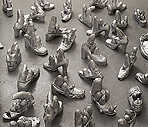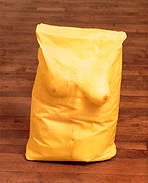
|
|
Mar. 18, 1997
|
Art Watch Index - Mar. 4, 1997
![]()
<<détruire dit-elle/il De-Genderism>>

Yayoi KUSAMA
Janine Antoni
Rebecca Horn
Robert Gober
"detruire dit-elle/il De-Genderism"
Setagaya Art Museum http://www.setagayaart museum.or.jp/
Eva Hesse - Reference Page
Profile: Matthew Barney
Yayoi Kusama
Yayoi Kusama - Reference Page
Mona Hatoum
MONA HATOUM
Mona Hatoum - Reference Page
BABY / Marie-Ange Guilleminot & Fabrice Hybert
Profile: Janine Antoni
FASHIONTELEVISIONGALLERY - ART
Janine Antoni - Reference Page
Rebecca Horn
Abramovic
Marina Abramovic - Reference Page
Robert Gober
ArtistGuide: Robert Gober
Robert Gober - Reference Page
Kazuhiko HACHIYA
Mattress Factory Past Works: Vito Acconci
Explorers: Vito Acconci
Vito Acconci - Reference Page
Ma Liuming in Setagaya
The Documentary of
|
The Body That "Phenomenalizes"
Compared to the recent listless retrospective exhibitions held in museums, the exhibition currently held at the Setagaya Art Museum is preeminent, in that it draws the audience into an adequately stimulating environment. Although the 15 artists selected from Japan and overseas (Eva Hesse, Matthew Barney, Yayoi Kusama, Mona Hatoum, Marie-Ange Guilleminot, Janine Antoni, Rebecca Horn, Marina Abramovic, Ma Liuming, Soo-Ja Kim, Go Kato, Robert Gober, Minako Nishiyama, Kazuhiko Hachiya, and Vito Acconci) share an aspect relating to the body, they are originally versatile, and cannot be sumarized in one word. For example, just taking Eva Hesse, she utilizes many methods in her expressions. This versatility, however, is also a way of expressing the difficult theme of the "body". The audience simply wanders through the differences. When one encounters a stimulant that he is interested in, he should look at the methodology of each artist with a certain amount of discomfort. That should feel somewhat familiar. The possibility of presenting the body There is probably noone who misses the clear and bold intention of this exhibition. When we enter into a realm which cannot be solved with reason, we cannot easily find a simple answer or a method with which we are satisfied. We realize for the first time that we must reconsider at that point. What do we know about the sexual body? Can we truly present the body itself? The sexual body is presented in a certain kind of "method" also by the artist who confronts the difficulty of entering into a troublesome realm that carries the potential of failure. This makes the body "phenomenalize" and perceive itself even better. A peaceful bisexual relationship or a clear sexual difference is out of the question from the beginning. Art is not something which regenerates what is thoroughly known. The view cast by art or the act created by it may be most important for us, human beings, but it is nothing else but a thought which investigates the realm that we do not understand, without any guarantee. It is not a wonder that there are as many sexual bodies, or rather, the bodies themselves, as the number of artists. From the methodology of him or her, the body appears as a mysterious phenomenon. We experience how each of the artist invites people into the mystery called the "body" using their imagination. It is not a wonder even if their trial ends in failure. Artists and philosophers have repeated failures concerning sex and the body. The daring impulse in which the artists desire us to see their reckless attempts towards the possibility of presenting the body can be felt. Even with this, there is some doubt whether we can declare that they are not repetitions. We are hungry for boldness even if we fall into total confusion. The creation of an image for the question about the mystery of man The title, "De-Genderism", interests me. The concept of "gender" which expresses the sexual difference created socio-culturally, definitely includes the political intention of an attack by the female towards the male-oriented society of the past. That deconstructs the conventional culture, and also should attempt an argument about what sex means. However, in a society where nothing is solved in reality, we cannot deny that a political "friend/enemy" relationship is constantly being born. Is the question concerning the body including sex possible in such a society? "De-Genderism" does not deny the political and cultural importance of the concept of gender, but it originates from a totally straightforward statement that what art investigates is what lies ahead of the gender concept. It is trying to see whether it can present the body, which carries the complexity of the sex, the strangeness, the failure and the violations, in methods that are exclusive to art. Although we say the "body itself", it must be expressed via some kind of media, method or material. Even if we say the "body itself", in the end, there are many means to an artist's investigation. Based on that assumption, if "De-Genderism" aims for something beyond all rational statements, I express agreement with what it advocates. Maybe it is trying to express the question towards the mystery of man in an image, by using the fragments of the world where the gender concept becomes destroyed and the fragments of the body which were overlooked. [Koji TAKI/Art Critic]
|
|
|
|
|
|
|
|
|
Mar. 18, 1997
|
[home]/[Art Information]/[Column]
Copyright (c) Dai Nippon Printing Co., Ltd. 1997
Network Museum & Magazine Project / nmp@nt.cio.dnp.co.jp


